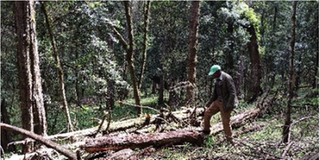‘The forest is our home and deforestation is wiping us out’

Joseph Lesingo stands next to poached cedar trees in Kiptunga Forest , Eastern Mau in Nakuru County.
What you need to know:
- The Mau Forest is one of the largest indigenous forests in Kenya.
- The 22 Ogiek clans had divided the forest into territories, and we lived in harmony with the forest.
“My name is Joseph Lesingo. I belong to the Ogiek Community, a forest-dwelling community in Kiptunga forest, Eastern Mau in Nakuru County. I was born in the forest. My parents and their parents as well. We are hunters and gatherers, surviving on honey and bushmeat from the forest.
The Mau Forest is one of the largest indigenous forests in Kenya, and my community colonised it even before the British came. The 22 Ogiek clans had divided the forest into territories, and we lived in harmony with the forest. We took care of the trees, and in turn, the forest nourished us.
But things changed when we got independence and the government took over all public forests. That’s when we started noticing the forest shrinking. Indigenous trees were felled to create plantation forests through exotic trees. Even if you walk into a plantation forest you will see stumps of indigenous trees that show you the original trees in that part of the forest.
This affected our lives drastically, the further we moved into the forest, the more the plantations drew closer. Our honey production has been going down, and the animals too have migrated and some have disappeared. This is because of the loss of vegetation that supplied the bees with nectar throughout. We lost our food.
What followed is parts of the land cleared from the forest being annexed for settlement and other communities migrated here. The forest was invaded as well by illegal loggers who poached the trees in the indigenous forests for charcoal and other timber uses. We felt marooned. For survival we have had to embrace subsistence farming. It has not been easy though.
In 2009, the government evicted us from the forest. This was during a campaign to save the Mau Forest. It felt like the worst betrayal, we have always protected the forest, when did we become the antagonists? We sued the government at the African Court on Human and Peoples Rights in Arusha in 2017 and won.
The government appealed, but, in June 2022, the court upheld its decision and instructed that the community be compensated for the land we lost and we were awarded Sh157,000,000 million in material and moral damages. To date, we have never been compensated and we would like the government to honour the court’s decision.
It is unfortunate that the current government is also blaming us (Ogiek )for the ongoing destruction of indigenous forests since the logging ban was lifted. I am the chairperson of the Kiptunga Community Forest Association and my core responsibility is protecting the forest with the help of everyone who benefits from this forest.
Whenever I get calls of poaching of indigenous trees, I notify the Kenya Forest Service Rangers for action. Cedar and Mahogany are the indigenous trees mostly poached and I can say they are threatened. Cedar is poached for poles and furniture making while Mahogany is burnt to produce charcoal.
The forest is a living thing and even when the trees are cut, it has a way of healing itself. But with pressure from human activities, the indigenous trees take a while before they can grow. The Ogiek’s way of life is constantly changing and I am afraid the more the forest is destroyed we shall be extinct as a community since we number less than 50,000 people.





